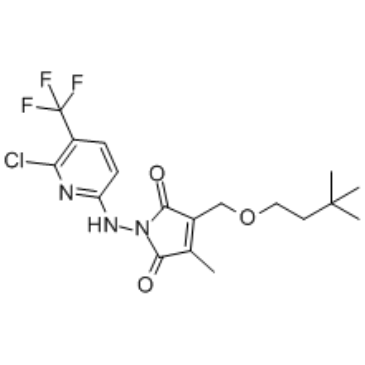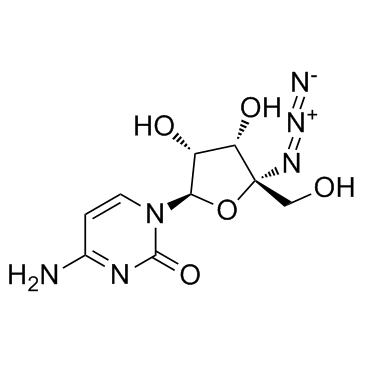 To enhance service speed and avoid tariff delays, we've opened a US warehouse. All US orders ship directly from our US facility.
To enhance service speed and avoid tariff delays, we've opened a US warehouse. All US orders ship directly from our US facility.
| Cat. No. | Product Name | Field of Application | Chemical Structure |
|---|---|---|---|
| DC24104 | Almorexant Featured |
Almorexant(ACT078573) is a potent and competitive dual orexin 1 receptor (OX1)/orexin 2 receptor (OX2) antagonist with Ki values of 1.3 and 0.17 nM for OX1 and OX2, respectively.IC50 value: 1.3/0.7 nM(OX1/OX2 receptor) [1] [2]Target: Dual OX!/OX2 receptorin vitro: [(3)H]Almorexant bound to a single saturable site on hOX(1) and hOX(2) with high affinity (K(d) of 1.3 and 0.17 nM, respectively. In Schild analyses using the [(3)H]inositol phosphates assay, almorexant acted as a competitive antagonist at hOX(1) and as a noncompetitive-like antagonist at hOX(2). In binding kinetic analyses, [(3)H]almorexant had fast association and dissociation rates at hOX(1), whereas it had a fast association rate and a remarkably slow dissociation rate at hOX(2) [1]. in vivo: During the 12-h dark period after dosing, ALM(Almorexant) exacerbated cataplexy in TG mice and increased nonrapid eye movement sleep with heightened sleep/wake fragmentation in both genotypes. ALM showed greater hypnotic potency in WT mice than in TG mice. The 100 mg/kg dose conferred maximal promotion of cataplexy in TG mice and maximal promotion of REM sleep in WT mice. In TG mice, ALM (30 mg/ kg) paradoxically induced a transient increase in active wakefulness [3]. Almorexant 200 mg showed significantly less 'Drug Liking' than both zolpidem doses (p < 0.01), and almorexant 400 mg had smaller effects than zolpidem 20 mg (p < 0.05), while almorexant 1,000 mg was not different from either zolpidem dose [4].
More description
|

|
| DC60184 | AZ194 Featured |
AZ-194 is a first-in-class, orally active inhibitor of CRMP2-Ubc9 interaction and inhibitor of NaV1.7 (IC50=1.2 μM). AZ194 blocks SUMOylation of CRMP2 to selectively reduce the amount of surface-expressed NaV1.7. Antinociceptive effects[1].
More description
|

|
| DC48369 | AGB1 Featured |
AGB1 is a fast, highly selective, and potent bump-and-hole (B&H)-PROTAC degrader for BromoTag. AGB1 exhibits degradation for Ab:Brd4BD2 L387A and Ab: BromoTag-Brd2 with pDC50s of 7.8 and 7.9. AGB1 exhibits binary affinity to VHL (Kd=125 nM). AGB1 exhibits favorable pharmacokinetic profile in mice with the DC50, 6 h of ∼13 nM.
More description
|

|
| DC23277 | AA-115 Featured |
AA-115 (APG 115) is a potent and orally active MDM2 inhibitor with Ki <1 nM, potently inhibits SJSA-1 cell growth with IC50 of 60 nM.
More description
|

|
| DC60243 | felezonexor(SL-801) Featured |
Felezonexor, also known as CBS9106, SL-801, and BMS566419, is a novel reversible oral CRM1 inhibitor with CRM1 degrading activity. CRM1 plays an important role in the nuclear export of cargo proteins bearing nuclear exporting signal sequences. CBS9106 inhibits CRM1-dependent nuclear export, causing arrest of the cell cycle and inducing apoptosis in a time- and dose-dependent manner for a broad spectrum of cancer cells, including multiple myeloma cells. CBS9106 reduces CRM1 protein levels significantly without affecting CRM1 mRNA expression. Oral administration of CBS9106 significantly suppresses tumor growth and prolongs survival in mice bearing tumor xenograft without a significant loss in body weight.
More description
|

|
| DC72890 | AHR-10037 |
AHR-10037 is a non-steroidal anti-inflammatory agent with low gastric toxicity. AHR-10037 is a prodrug converted in vivo to a cyclooxygenase inhibitor.
More description
|

|
| DC72889 | TP-1287 |
TP-1287, a prodrug of Alvocidib, is an orally active CDK9 inhibitor.
More description
|

|
| DC72887 | ML 2-23 |
ML 2-23 is a potent PROTAC BCR-ABL degrader. ML 2-23 is selectively degrade BCR-ABL in a proteasome-dependent manner in leukemia cells.
More description
|

|
| DC72884 | Ethyl methanesulfonate |
Ethyl methanesulfonate is a DNA ethylating agent, mutagenic to plants and animals and carcinogenic in mammals. It has been used as a model alkylating agent in studies of DNA repair processes. It induces base substitutions of guanine-cytosine (G/C) to adenine-thymine (A/T). EMS also generates point mutations and single nucleotide polymorphisms in genomes.
More description
|

|
| DC72883 | GBT1118 |
GBT1118 is a potent and orally active allosteric modifier of hemoglobin oxygen affinity. GBT1118 increases tolerance to severe hypoxia.
More description
|

|
| DC72881 | MEN 11270 |
MEN 11270, a cyclic decapeptide, is a B2 kinin receptor antagonist. MEN 11270 bound with high-affinity to the B2 kinin receptor constitutively expressed by WI38 human fibroblasts, inhibiting 3H-bradykinin (BK) with pKi of 10.3.
More description
|

|
| DC72878 | B 746 |
B746 is a clofazimine analog with anti-Mycobacterium avium complex (MAC) activity and is less effective when used with clofazimine or streptomycin.
More description
|

|
| DC24007 | R-1479 Featured |
A potent, specific inhibitor of HCV NS5B polymerase and HCV replication (IC50=1.28 uM, replicon assay).
More description
|

|
| DC11661 | BAY 73-6691 |
BAY 73-6691 is a drug developed by Bayer for the treatment of Alzheimer's disease. It was the first compound developed that acts as a phosphodiesterase inhibitor selective for the PDE9A subtype.
More description
|

|
| DC20410 | Hydrazinocurcumin Featured |
Hydrazinocurcumin is a synthetic curcumin derivative that inhibits the proliferation of bovine aortic endothelial cells (BAECs) with IC50 of 520 nM without cytotoxicity, inhibits STAT3 phosphorylation and downregulates an array of STAT3 downstream targets.
More description
|

|
| DC9819 | Guanoclor Featured |
Guanoclor is a sympatholytic drug. It is known to bind to non-adrenergic sites in pig kidney membranes.
More description
|

|
| DC65341 | [18F]PSMA-1007 Featured |
[18F]PSMA-1007, a positron emission tomography (PET) tracer, specifically targets prostate-specific membrane antigen (PSMA), which is highly expressed in prostate cancer. PSMA-PET is effective especially for regional detection of biochemical recurrence, which significantly affects patient management. Herein, we established and optimized a one-step radiolabeling protocol to separate and purify [18F]PSMA-1007 with a CFN-MPS200 synthesizer for clinical application.
More description
|

|
| DC10645 | Phorbol 12-myristate 13-acetate (PMA) Featured |
Phorbol 12-myristate 13-acetate (PMA) is a PKC-activating phorbol ester, increases the intracellular Ca2+ concentration ([Ca2+]i) in a dose-dependent manner, with an EC50 of 11.7 nM.
More description
|

|
| DC31458 | Tipranavir Featured |
Tipranavir is a nonpeptidic protease inhibitor. Tipranavir has the ability to inhibit the replication of viruses that are resistant to other protease inhibitors and it recommended for patients who are resistant to other treatments. Resistance to tipranavir itself seems to require multiple mutations. Tipranavir was approved by the Food and Drug Administration (FDA) on June 22, 2005, and was approved for pediatric use on June 24, 2008. Like lopinavir and atazanavir, it is very potent and is effective in salvage therapy for patients with some drug resistance.
More description
|

|
| DC45688 | Atrovastatin-PEG3-FITC Featured |
Atrovastatin-PEG3-FITC (compound S31) is a KRAS-PDEδ interaction inhibitor. Atrovastatin-PEG3-FITC acts as a ligand in fluorescence anisotropy assay.
More description
|

|
| DC65347 | A-674563 HCl Featured |
A-674563 is a potent and selective Akt1 inhibitor with Ki of 11 nM. A-674563 suppressed the activation of the NLRP3 inflammasome in cardiomyocytes following β-adrenoceptor activation, suggesting that AKT1 is a critical regulator molecule upstream of the NLRP3 inflammasome. A-674563 suppresses CDK2 activity, inhibits human NSCLC cell growth more effectively than the pan-AKT inhibitor, MK-2206
More description
|

|
| DC71974 | BE1218 Featured |
BE1218 is a liver X receptor (LXR) inverse agonist with IC50 values of 9 nM and 7 nM against LXRα and LXRβ, respectively.
More description
|

|
| DC65346 | ZM-226600 Featured |
ZM-226600 is a potent Kir6 (KATP) channel opener (EC50 = 0.5 μM), devoid of antiandrogen properties. ZM226600 is more active than oxybutynin in reducing bladder overactivity, and it is devoid of vascular side effects observed with pinacidil. Its short duration of action (about 1 h) is probably the main problem to solve, in order to consider this compound a valid alternative to antimuscarinics in the therapy of bladder overactivity.
More description
|

|
| DC65345 | TRV-7019 Featured |
TRV-7019 is a BBB-penetrable radioligand for brain imaging that target butyrylcholinesterase. TRV-7019 can be used for the diagnosis of an amyloid disease, multiple sclerosis, a brain tumor, or butyrylcholinesterase activity.
More description
|

|
| DC72535 | TUG-499 Featured |
TUG-499 is a selective free fatty acid receptor 1 (FFAR1 or GPR40) (Free Fatty Acid Receptor) agonist with a pEC50 of 7.39. TUG-499 exhibits >100-fold selectivity over the related receptors FFA2, FFA3, and the nuclear receptor PPARγ and other diverse receptors, ion channels, and transporters. TUG-499 can be used for the research of type 2 diabetes.
More description
|
.png)
|
| DC22429 | 4-BBPB Featured |
A highly potent agonist of σ1 receptor with Ki of 0.8 nM.
More description
|

|
| DC65344 | KWCN-41 Featured |
KWCN-41 is a selective and efficient inhibitor of RIPK1 kinase with an IC50 value of 88 nM. KWCN-41, specifically inhibiting cell necroptosis but not apoptosis, protects cell survival by blocking the necroptotic pathway, which inhibits the phosphorylation of essential proteins of the necroptosis. It also prevented the development of inflammation and reduced the level of inflammatory factors in mice. KWCN-41 is expected to be a lead compound for further studies in inflammatory diseases.
More description
|

|
| DC11127 | HS94 Featured |
HS94 (DAPK3 inhibitor HS94) is a selective DAPK3 inhibitor with Ki of 126 nM, >20-fold selectivity over Pim kinases..
More description
|

|
| DC65343 | SU-5616 Featured |
SU-5616 is a biochemical reagent. SU 5616 potentially modulates tyrosine kinase signal transduction, and regulates abnormal cell proliferation.
More description
|

|
| DC42600 | GPX4-Activator-1d4 Featured |
Novel Potent Allosteric Activator for Ferroptosis Regulator Glutathione Peroxidase 4 (GPX4)
More description
|

|